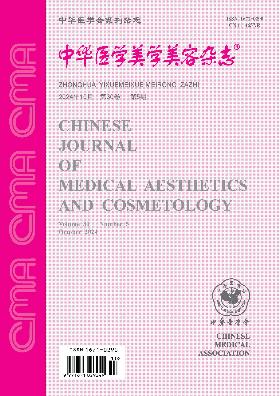Clinical experience of butterfly costal cartilage as columella strut graft
引用次数: 0
Abstract
Objective To discuss the use of butterfly costal cartilage as columella strut graft. Methods On the costal cartilage that being cut, butterfly graft was designed length of 2.8 cm, upper and lower end thickness of 5 mm, middle part thickness of 1.5 mm. The lower end was designed with a groove about 1 cm in length, the width of the lower end of the butterfly graft was determined according to the degree of retraction at the caudal end of the septum, then insert to the nasal crest. The posterior end of two lamella grafts was sutured and fixed with the middle part of the nasal columnar strut graft. Results From November 2016 to March 2018, about 150 patients underwent rhinoplasty with this method, follow-up was 3 to 12 months. Two cases had mild nasal tip deviation one month after surgery and were adjusted with auricular cartilage three months later. Three patients had mild postoperative hyporotation and adjustment three months postoperatively, residual had good shape. Conclusions The stability and controllability of the sphenoid columella strut graft are good, out of shape not easily, It is a worthy clinical method. Key words: Nose; Surgery, plastic; Costal cartilage; Autografts蝶肋软骨作为小柱支柱移植的临床经验
目的探讨蝶肋软骨作为小柱支柱移植物的应用。方法在切除的肋软骨上,蝶形移植物设计长度为2.8 cm,上下端厚度为5 mm,中间部分厚度为1.5 mm,下端设计有约1 cm长的凹槽,根据鼻中隔尾端的回缩程度确定蝶形移动物下端的宽度,然后插入鼻嵴。将两个片层移植物的后端与鼻柱状支柱移植物的中部缝合固定。结果2016年11月至2018年3月,约150名患者采用该方法进行了隆鼻术,随访时间为3-12个月。2例术后1个月出现轻度鼻尖偏斜,3个月后用耳软骨矫正。3例患者术后3个月出现轻度低旋转和调整,残余物形态良好。结论蝶柱支柱移植物稳定性好,可控性好,不易变形,是一种值得临床应用的方法。关键词:鼻子;整形外科;肋软骨;自体移植物
本文章由计算机程序翻译,如有差异,请以英文原文为准。
求助全文
约1分钟内获得全文
求助全文
来源期刊
自引率
0.00%
发文量
4641
期刊介绍:
"Chinese Journal of Medical Aesthetics and Cosmetology" is a high-end academic journal focusing on the basic theoretical research and clinical application of medical aesthetics and cosmetology. In March 2002, it was included in the statistical source journals of Chinese scientific and technological papers of the Ministry of Science and Technology, and has been included in the full-text retrieval system of "China Journal Network", "Chinese Academic Journals (CD-ROM Edition)" and "China Academic Journals Comprehensive Evaluation Database". Publishes research and applications in cosmetic surgery, cosmetic dermatology, cosmetic dentistry, cosmetic internal medicine, physical cosmetology, drug cosmetology, traditional Chinese medicine cosmetology and beauty care. Columns include: clinical treatises, experimental research, medical aesthetics, experience summaries, case reports, technological innovations, reviews, lectures, etc.

 求助内容:
求助内容: 应助结果提醒方式:
应助结果提醒方式:


